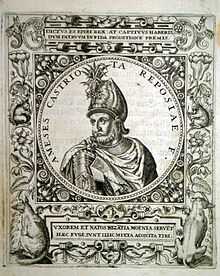Hamza Kastrioti
| Hamza/Branilo Kastrioti | |
|---|---|
 Hamza Kastrioti | |
| Noble family | Kastrioti family |
| Father | Stanisha Kastrioti[1] |
Hamza Kastrioti (lat. Ameses Castriota) was the nephew of George Kastrioti Skanderbeg. Probably born in Ottoman territory, after the death of his father he was raised by Skanderbeg, who took him in his military expeditions. After the Battle of Niš he deserted Ottoman troops together with his uncle Skanderbeg, converted to Christianity and changed his name to Branilo.[2] He supported Skanderbeg's uprising and was the vice captain of Skanderbeg's troops when they captured Kruja in 1443.
In 1448 Skanderbeg's forces under command of Hamza Kastrioti and Marin Spani occupied the abandoned Baleč and reconstructed it when Skanderbeg began his war against Venice. Hamza Kastrioti did not want to stay in the fortress and went to Drivast leaving Marin Span with 2,000 soldiers in Baleč.[3] Marin found newly reconstructed fortress insecure and retreated with his soldiers toward Danj as soon as he was informed by his relative Petar Spani about the large Venetian forces heading toward Baleč.[4] Venetian forces recaptured Baleč, burned wooden parts of the construction and destroyed reconstructed walls of the fortress.[5]
After the marriage of Skanderbeg and the birth of his son Gjon, Hamza Kastrioti lost every hope of inheriting the principality of Kastrioti.[6] He deserted to the Turkish Sultan Mehmed II in 1457[6][7] and alongside with Isak-Beg he was one of the commanders of the Ottoman troops in the Battle of Ujebardha.[8] In that battle he was captured by Skanderbeg's forces and placed in detention in Naples on charges of treason. He was later freed and went to join his wife and children in Constantinople, and continued to serve in the Ottoman high ranks. His loss was regarded as a tragedy by Albanians. He was one of the most brilliant generals of Skanderbeg and was very popular among the soldiers for his manners, second only to Skanderbeg. According to historians, along with him, League of Lezhë lost the chance to continue what Skanderbeg had begun.[8]
References
- ↑ Dialogue, Volume 5, Issues 17-20. Dijalog. 1996. p. 78. Retrieved 27 March 2012. "Posle bitke kod Pirota, Skenderbeg zajedno sa sinovcem Hamzom, sinom svog starijeg brata Staniše ..."
- ↑ Dialogue, Volume 5, Issues 17-20. Dijalog. 1996. p. 78. Retrieved 27 March 2012. "(prešavši u hrišćanstvo Hamza će uzeti ime Branilo, po svom čukundedi)..."
- ↑ Glas, Volumes 319-323 (in Serbian). Belgrade: Serbian Academy of Science and Arts. 1980. p. 39. Retrieved 20 January 2012. "За команданта балечке посаде Скендербег је одредио свог нећака Амесу (Хамзу) и Марина Спана. Али се Амеса тамо није хтео задржавати, већ зе кренуо на Дриваст, а Марин се с 2 ООО својих људи осећао угрожен у тек обновљеном граду"
- ↑ Glas, Volumes 319-323 (in Serbian). Belgrade: Serbian Academy of Science and Arts. 1980. p. 55. Retrieved 20 January 2012. "... да поруше обновљени Балеч с таквим снагама као да је у питању највећа тврђава. То је Петар Спан јавио свом рођаку Марину и овај је у последњем тренутку сакупио војнике и спустио се према Дању"
- ↑ Glas, Volumes 319-323 (in Serbian). Belgrade: Serbian Academy of Science and Arts. 1980. p. 39. Retrieved 20 January 2012. "... Млечани су запалили дрвену грађу а свеже зидове сравнили са земљом"
- ↑ 6.0 6.1 Noli, Fan Stylian, George Castroiti Scanderbeg (1405–1468), International Universities Press, 1947 p.52
- ↑ Scanderbeg Authors Harry Hodgkinson, Bejtullah D. Destani, Westrow Cooper, David Abulafia Editor Bejtullah D. Destani Edition illustrated Publisher Centre for Albanian Studies, 1999 ISBN 1-873928-13-0, ISBN 978-1-873928-13-4 p.144
- ↑ 8.0 8.1 Noli, Fan Stylian, George Castroiti Scanderbeg (1405–1468), International Universities Press, 1947 p.53